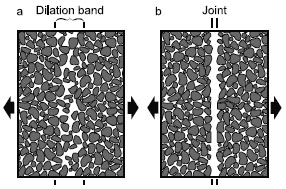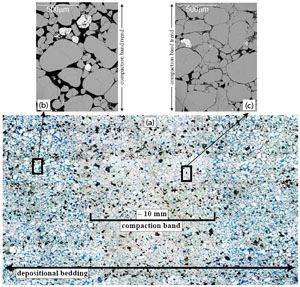| |||||||
|
|
|||||||
|
|
|||||||
| Mechanisms and Mechanics of Volumetric Bands | |||||||
|
Volumetric bands are associated with primarily volumetric strain localization. Dilation bands form in response to and generally perpendicular to the maximum remote extensional stress (Du Bernard et al., 2002). On the grain scale, deformation mainly involves the enlargement of pore space between, or through, the neighboring grains (Figure 1) and may have some lateral shift with respect to adjacent grains. In contrast, compaction bands form in response to, and generally perpendicular to, the maximum remote compressive stress. It is commonly assumed that they initiate with the collapse of pore or grain-scale flaws, and then propagate outward to form tabular inclusions of compacted material of a few centimeters thick and tens of meters in planar extent. Viewed in thin section (Figure 2), the boundaries of compaction bands can be delineated within the precision of a few grain size (Figure 2a). Judging from the overall continuity of the depositional bedding cut by the bands (Figure 2a), and absence of granular disaggregation despite grain fracturing, the volume change appears to have resulted from uniaxial compaction normal to the plane of the band. Relatively high porosity, greater than 10 to 15 percent (Holcomb et al., 2007 and Aydin et al., 2006), appears to be necessary for the formation of compaction bands. In addition, the rock mineral composition and presence and content of cement appear to have a significant influence on compactive strain localization (Haimson and Lee, 2004). Several laboratory investigations have produced compaction bands. Olsson (1999) and Olsson and Holcomb (2000) are among those who produced compaction bands and documented their transverse growth or thickening in experiments. Wong et al. (2001) have also produced discrete compaction bands in the laboratory. The associated stress-nominal strain curves have a saw-tooth appearance, with the local stress drops correlating with the formation of individual bands. In contrast to the wide compaction bands observed by Olsson and Olsson and Holcomb, the compaction bands in Wong's experiments are thin and interlayered with uncrushed material. Different theoretical approaches have been taken to describe the formation or the nucleation and propagation of compaction bands. We have mentioned the Cap model under deformation bands. However, the longitudinal extension of bands to lengths of tens of meters requires propagation due to stress concentration at their tips (Sternlof et al., 2005; Katsman et al., 2006). A good summary of these models are given by Rudnicki (2007). | |||||||
| Reference: |
|||||||
| Aydin, A., Borja, R., Eichhubl, P., 2006 Du Bernard, X., Eichhubl, P., Aydin, A., 2002 Haimson, B.C., Lee, H., 2004 Holcomb, D., Rudnicki, J.W., Issen, K.A., Sternlof, K.R., 2007 Katsman, R., Aharonov, E., Scher, H., 2006 Olsson, W.A., 1999 Olsson, W.A., Holcomb, D., 2000 Rudnicki, J.W., 2007 Sternlof, K.R., Rudnicki, J.W., Pollard, D.D., 2005 Sternlof, K.R., 2006 Wong, T.F., Baud, P., Klein, E., 2001 |
|||||||
|
Readme | About Us | Acknowledgement | How to Cite | Terms of Use | Ⓒ Rock Fracture Knowledgebase |
|||||||

